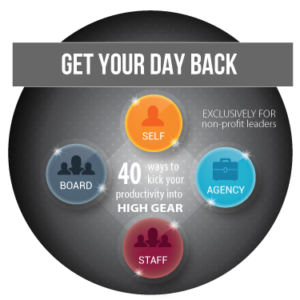Declining productivity can suck the life out of a non-profit… and a non-profit leader.
Feeling overwhelmed? Way too much to do and no where near enough time? Never-ending to-do list? Sometimes I think when it comes to productivity, we can be our own worst enemies. We have certain practices and habits that — while we think they are helpful — can actually undermine our efforts for success.
Take me for instance. It took me a long time to realize I am a morning person. I have no problem getting up and into my office by 6 AM. I came to understand I am most productive early because I am the freshest and least likely to be distracted when I can start my day early. And once I get really going into project, I can carry that focus and energy through much of the day. But if I put off my creative work until later in the day, forget it! It usually turns out poorly and I have to start all over the next day.
Another challenge I have is forcing myself to get some task or project done when I really don’t feel like doing it. If I wait until that point to start a project, most of the time, the end product is of poor quality and has to be redone.
So, what habits, preferences, and practices do you have that may be inhibiting your becoming the best version of yourself? What might you be doing that holds you back from being your most productive self? Are there secret productivity killers in your agency? What are they, and what can you do about them?
The Productivity Quiz can help you identify what productivity challenges you might have — as a leader, and in your organization. You can also learn how to begin to take action to fix these challenges, and double your productivity.
The 4 Key Areas are Self, Board, Organization (Agency), and Staff.
I’ve tried to organize them by how I see them centered. Often the most difficult — but most impactful— area to begin is within ourselves.
Within these 4 Key Areas, I’ve identified 40 secret productivity killers for non-profit leaders. Do any of these affect you or your organization?
Self
- Not setting priorities every morning and at the start of each week.
- Not analyzing your calendar each week (like you probably analyze your checkbook) to see if you are wisely spending your time according to your set priorities?
- Over-scheduling your self without building in any breaks or time to refresh yourself.
- Not stepping back from our organization periodically to take a 30,000 foot look at your organization.
- Not recognizing your strengths or hiring people around you to bridge your weaknesses.
- Not making decisions based on organization’s Mission, Vision, Values, and strategic plan.
- Adopting a “my way or the highway” leadership style.
- Rejecting ideas and best practices that were “ not invented here”
- Not embracing a certain amount of healthy friction, discomfort, or disagreement from well-intended staff, board members, or donors.
- Not continuing to invest in oneself by continuing to learn new things or skills.
Board
- Having a poor working relationship with the chair and directors.
- Not clearly understanding what the board expects from you.
- Not using the board to its full potential and ability.
- Making “safe” new director recommendations rather than recruiting strong candidates with much to share.
- Not leveraging the board’s networks, skill sets, and experiences.
- Not insisting on a personal annual review by the board.
- Not recommending conducting annual board and director assessments.
- Not calling for bi-annual organizational assessments.
- Not being fully transparent with the board on issues they need to know fully.
- Not providing your leadership team with opportunities to interact and engage with the board.
Organization
- Micro-managing your team.
- Not stretching or challenging your team with interesting assignments.
- Not recognizing the difference between expenses and investments.
- Not meeting with your leadership team regularly and frequently.
- Not providing honest an helpful feedback when conducting employee reviews.
- Getting lost in the details of the organization and losing sight of the big picture.
- Retaining client programs that should be dropped, revised, or transferred to another agency.
- Not holding open meetings with staff periodically to answer questions and provides organizational updates.
- Not making necessary changes to plans and strategies when conditions change requiring new thinking.
- Not being able to measure results of the organization’s most critical activities and programs to monitor effectiveness, thereby building a mindset of continuous improvement.
Staff
- Fear of hiring people more skilled or “smarter” than themselves.
- Not developing ones subordinates.
- Not delegating everything that others can do and only retaining those duties the ED can do.
- Playing favorites.
- Not recognizing when someone is not a good fit and should be retrained or released.
- Not seeking or welcoming input from others.
- Not providing training so the staff can learn, grow and take on more responsibilities.
- Not making time to just walk around and listen to staff.
- Missing opportunities to help your staff understand your vision, strategy, and how they fit into the bigger picture.
- Not encouraging your team to make mistakes, learn new things, and take chances.
Is there anything else you would add to the list?
Do you recognize any personal habits or practices on the list that you may want to change in your leadership style?
If you think any of these challenges might be holding you back, download the Get Your Day Back workbook, and take the Productivity Quiz to find out how to kick your productivity into high gear!


